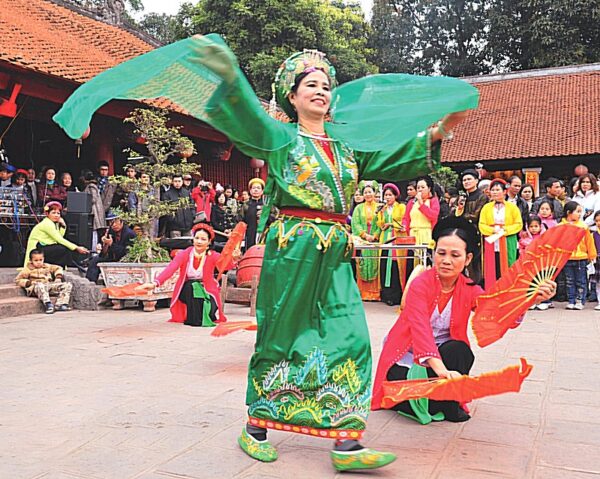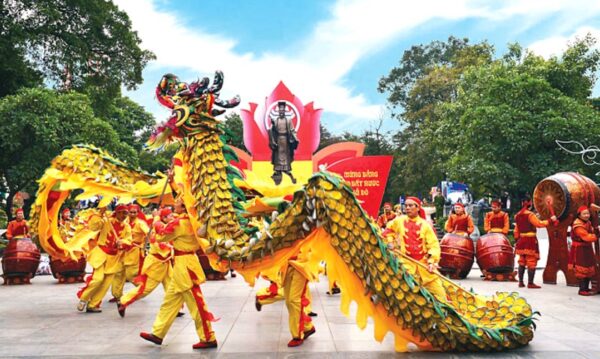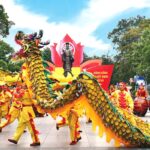This is a good sign of a real transformation. Culture is continuing to light the way, awaken, highlight, and create great motivation on the journey to the future!

The rich system of tangible and intangible cultural heritage is an endless “gold mine” of Hanoi Capital. Photo by: Nguyen Thanh
- Among the cultural resources that make up Vietnam’s soft power, Thang Long – Hanoi has a special position and mission. As a place of convergence, crystallization and spreading of the nation’s most noble values, Thang Long – Hanoi is the “golden core” of Vietnamese culture.
The whole system of noble values of the whole rich system of tangible and intangible heritage is an endless “gold mine” of Thang Long – Hanoi. That cultural potential must become a cultural resource and a soft power of the capital. Especially, as the center of politics, culture, science and technology, economy and international exchange, Hanoi is definitely and forever the cultural capital of Vietnam.
The historical and cultural relics in Thang Long – Hanoi are invaluable heritage. Over thousands of years, with so many violent fluctuations between dynasties and historical periods, Hanoi today holds in its heart overlapping relics. Therefore, when building works, it is difficult to avoid touching relics on the ground or underground. The most important task is to have the right attitude and the right behavior. This is the attitude towards the past, present and future. Conservation should never be the reason for hindering development; and development should never harm conservation. Hanoi is giving a valuable experience when dealing with this problem.
Nearly 20 years ago, at 18 Hoang Dieu Street, the archaeological excavation was at first just to clear the ground for the construction of the National Convention Center and the National Assembly House. When 10,000 square meters in area A, area B, and part of area D were excavated, layers of relics of the ancient Thang Long Imperial Citadel suddenly appeared. Before a special heritage treasure that has just been discovered, leaders of the Party and State have decided to move the construction site of the National Convention Center to My Dinh. Of the 20,000 square meters area in 18 Hoang Dieu, only 9,000 square meters were used to build the National Assembly House, while Area A and Area B were spent entirely to the preservation of Thang Long Imperial Citadel.
Messages from the ground, echoes of history awakened and reminded us to act right. A multi-purpose historical – cultural park was decided to build by combining the National Assembly House project and the project of preserving the vestiges of the ancient Thang Long citadel into one overall project. This is a typical case of harmoniously solving the problem of conservation – development, so that the National Assembly can still be built while we still preserve an extremely precious heritage left behind for eternity and recognized by UNESCO.
Heritage conservation is not only for traditional education, balancing social consciousness but also creating development resources. Knowledge is a must to classify what needs to be completely preserved without being touched, what is partially preserved, what should be put into the museum with very scientific steps.
Although it has been suffering from the silent but very violent impact of the wave of industrialization, modernization, and the digital information age, Hanoi is still trying to keep its soul of the sacred and pompous eternal capital. The soul is everything we love and are proud of about Hanoi, and also the most inmost, delicate, pure, and loving thing. It is looming and sparkling in the scenery of Hanoi, in the behavioral culture of Hanoi people. This is a civilized, modern Hanoi but still full of emotions and dreams, a loving Hanoi so that we can live happily in the Thang Long – Hanoi biosphere.
Hanoi is expanding more pedestrian streets around Hoan Kiem Lake. It is an additional beauty work, which is recognized as a cultural act to contribute to the preservation of precious values of the thousand-year-old capital.
- Building culture is building people. Human development and perfection need and can only be realized in culture and by culture. Public culture, office culture, traffic culture, environmental culture and a lot of other things have to be done synchronously, but I think it is important to pay special attention to culture in education and schools. Culture is the environment of education.
Behavioral culture is the face of culture. Perhaps many people still remember that more than 30 years ago, two political documentaries “Hanoi in those eyes” and “Story of kindness” by director Tran Van Thuy were premiered and deeply moved the minds of Hanoians. Nowadays, kindness is still a hot topic not only in Hanoi. Kind people and good deeds are not rare around us, but bad deeds and unkind people seem to be not less, while the way of expression tends to spread through violent and cruel attack on social networks.
No matter how magnificent the city is, it is only really worth living when people know and want to live decently. Humanity and kindness must be the warm fire and light in the life of every person, family and society as a whole. So many good deeds which are full of human love in the fight against the Covid-19 pandemic in Hanoi as well as many localities throughout the country have once again brightened the spirit of solidarity and deep benevolence in our society.
How can the cultural values of the capital, the character, the mettle and the elegance of the Hanoians continue to be maintained and transformed into daily actions and exemplary lifestyles for the whole country? This requires every Hanoian to always be deeply aware of the honor and responsibility of being a “citizen of the capital”. Hanoi people really need a sense of self-discipline for cultural renaissance. However, besides education and persuasion, there should be sanctions to force people to comply, thereby forming a habit, gradually forming a lifestyle. The two codes of conduct that Hanoi is implementing have shown the strong determination of the city’s leaders in building a culture of behavior in the capital. Citizens of the capital are not only confirmed by household registrations and citizen identity cards but also need “cultural identity” in each person.
- Culture must be placed on a par with economy and politics, our entire system needs to be deeply aware that in every economic and political decision, culture needs to be present to illuminate, warn and adjust. However, in reality, culture is still overlooked, sometimes ignored, and often left behind in the allocation of benefits and resources, including the most important thing which is the arrangement of personnel. There is also a fairly common situation that culture is just considered a kind of entertainment, not a major matter, and even despised sometimes. The misinterpretation has led to very serious consequences. Culture is absent or blurred both in the process of making and administering policies, in the priority order of solving urgent problems of social life. There have been real estate projects that devour essential cultural needs; In many places, there is a shortage of land fund for kindergartens, preschools and cultural works. Obviously, when culture is overlooked, market factors will prevail, material benefits will knock out spiritual values, even uncultured and inhumane factors can penetrate into the political and economic environment, causing unpredictable consequences.
Meanwhile, if we instill the role and value of culture, all cultural activities, if well organized, will certainly bring significant economic benefits. In the economic value brought by culture, there will also be spiritual value. Several years ago, city leaders resolutely withdrew a series of big commercial projects that threatened to infringe on culture. Recently, the Red River Urban Subdivision Planning as much as 70% of the area for trees which has been highly appreciated by the Bui Xuan Phai Award Council – For the love of Hanoi and awarded the Idea Award. It is a beautiful cultural attitude towards the living environment. Hereby, on the basis of culture, good opportunities will be opened up for economic development associated with culture.
Thang Long – Hanoi has always been a place of convergence, crystallization and spreading of the nation’s noblest values.

Photo by: Thanh Ha
- Hanoi has a rare local advantage to develop cultural industry. Recently, there have been many lively seminars, forums and discussions on this issue. The cultural industry in the capital needs to promote the values of the extremely rich tangible and intangible heritage systems of Thang Long culture and Doai culture.
Three years ago, during my visit to China, I had the opportunity to visit the majestic film studios of famous films such as “Romance of the Three Kingdoms”, “Journey to the West”, “Water Margin” which are adapted from the masterpieces of Chinese literature. Tourists flocking to visit and experience have turned these studios into famous tourist destinations, bringing in significant revenue. I also visited Jeju Island located in the southernmost part of Korea, which was chosen as the setting for the movie “Winter Sonata”. There is a large photo of a romantic scene from the movie between the two main characters. Among the crowd, no one seemed to forget to take a picture of that big picture. That is the great benefit from cultural tourism. Korea is a very successful country in the development of the cultural industry (currently accounting for 9% of GDP), in which cinema, music and fashion are three “unique moves” which are storming in the international market, conquering the public on a global scale, contributing to the “miracle Korea”.
Vietnam has set a target that by 2030, the cultural industry will account for 7% of GDP. Hanoi, with its leading role, is the largest cultural industry center in the country, and it is estimated that this figure must reach at least 10% of the city’s GDP. It is not an easy goal, requiring breakthrough solutions.
As the results of an international poll recently announced, Hanoi is ranked among the 10 most attractive tourist cities in the world; Another international poll ranked Hanoi Pho as one of the 10 best dishes. However, the management, protection and exploitation of tourism resources of Hanoi still have many shortcomings, not commensurate with the value of its monuments and advantages.
As the capital of a thousand years of civilization, the Capital of Heroes, and the City for Peace, Hanoi has been recognized by UNESCO as a Creative City. This is a very favorable premise for Hanoi to develop cultural industry. Of the four essential factors for the development of the cultural industry (heritage resources, policy, technology and creativity), Hanoi has the two most fundamental factors: heritage resources and creativity. Participating in the cultural industry is a team of intellectuals, writers and artists, organizers of production and distribution of cultural products and services, and people from all walks of life. The State only creates a legal corridor, an open mechanism for a favorable creative and business environment, maximizing the participation of the private sector, especially the young creative force. Along that path, the Hanoi Rethink Project, centered on young people, will create and promote the foundation for connecting cultural initiatives, supporting the integration of new technologies into the creative industries of young people.
Large cities are often built by large rivers. The Red River has 40km flowing through Hanoi. This is an ideal space for creativity, where all creative ideas are converged, intersected and introduced to a large number of classes at home and abroad. It is hoped that this place will become a vibrant development space, a strong push for the cultural industry, to realize the vision of Hanoi becoming a leading innovation center in Southeast Asia.
As an open culture that accepts and respects different values, in the process of exchange and assimilation, Vietnamese culture in general and Thang Long – Hanoi in particular have determined to maintain core traditional values, while selecting the quintessence and experience of other countries to enrich their culture, including how to develop the cultural industry. We are going to the future with the motto “Vietnamese spirit, world quintessence”.
- Throughout its history, Thang Long – Hanoi is a land of special attraction for literature and art, and it is literature and art that has contributed to shimmering and shining the thousand-year-old civilization of Thang Long – Hanoi and of our nation.
This sacred and pompous land has produced many famous artists and writers, and at the same time, has an incomparable attraction for artists from all over the world who sing their hearts out and make wonderful sounds to nurture the souls, build the character of the Vietnamese people in general and Hanoi people in particular.
With special inspirational power, literature and art contribute to nourishing the souls, becoming a moving and awakening light. The talents of intellectuals and artists are treasure of the capital and the country. It can be said that intellectuals and artists have never had the opportunity to promote their creative abilities like today. The capital’s writers and artists will always dedicate and devote themselves to cultivating the soul and character of Hanoians with works of high ideological and artistic value. Literature and art will participate more actively and effectively in the cultural industry. Film studios and broadcasters need good screenplays. Theaters need good theatrical scripts. Publishers need high-quality book manuscripts. Cultural and artistic production and service units are eagerly waiting for literary and artistic works of high ideological and artistic value to be staged and served to the public.
For the career of renaissance and development of Hanoi’s culture, besides the experienced team who have made proud contributions, it is in dire need of young new faces who are full of desire to devote and have full of creative energy so that culture is really an endogenous resource and the driving force for the construction of the capital and the country in the new era.
HỒ QUANG LỢIdientu@hanoimoi.com.vn

